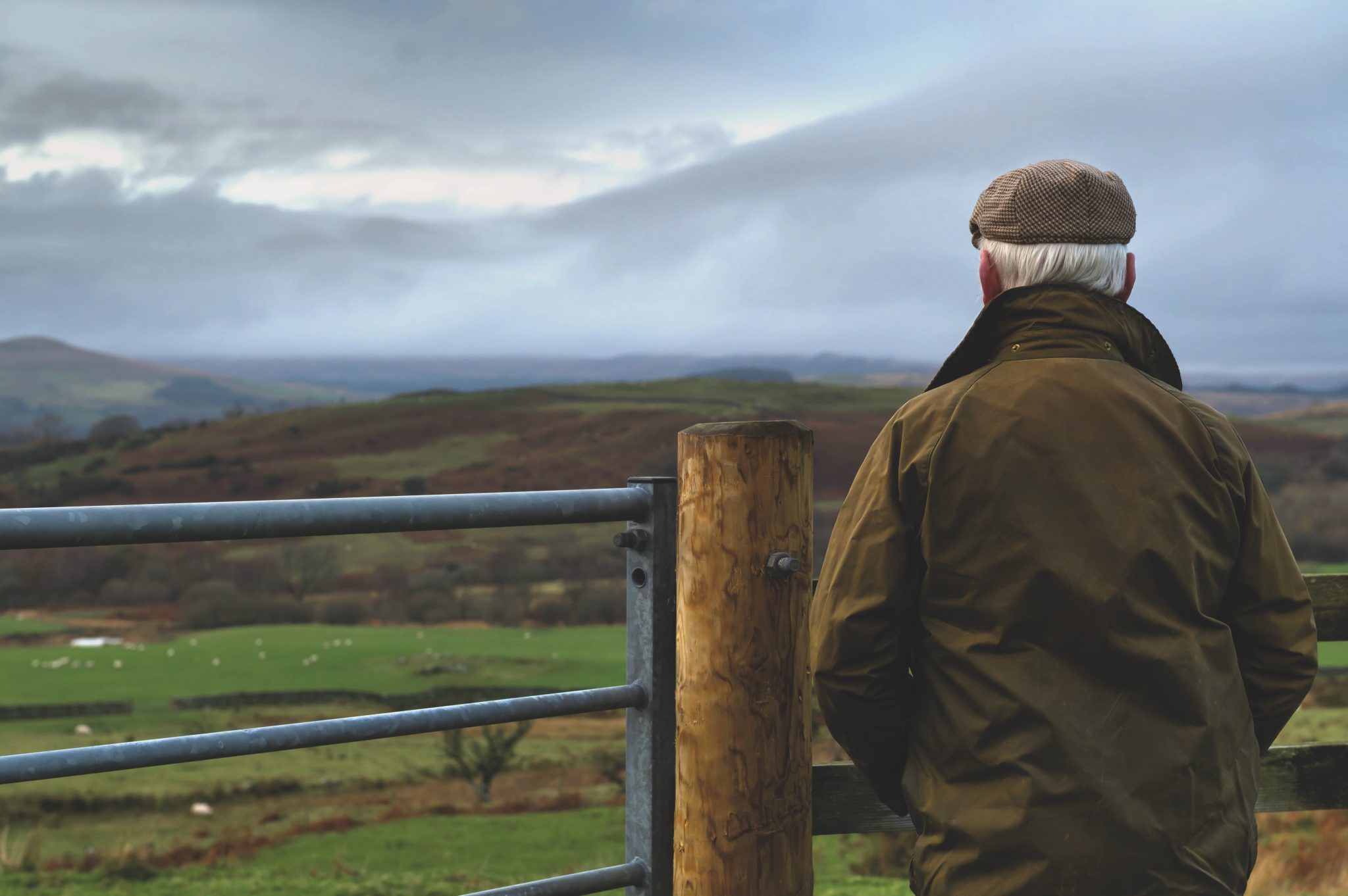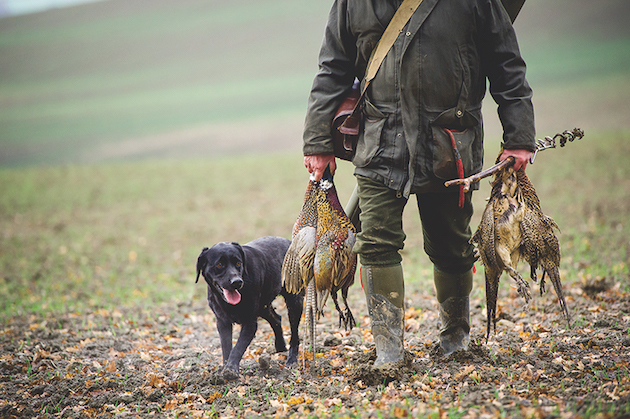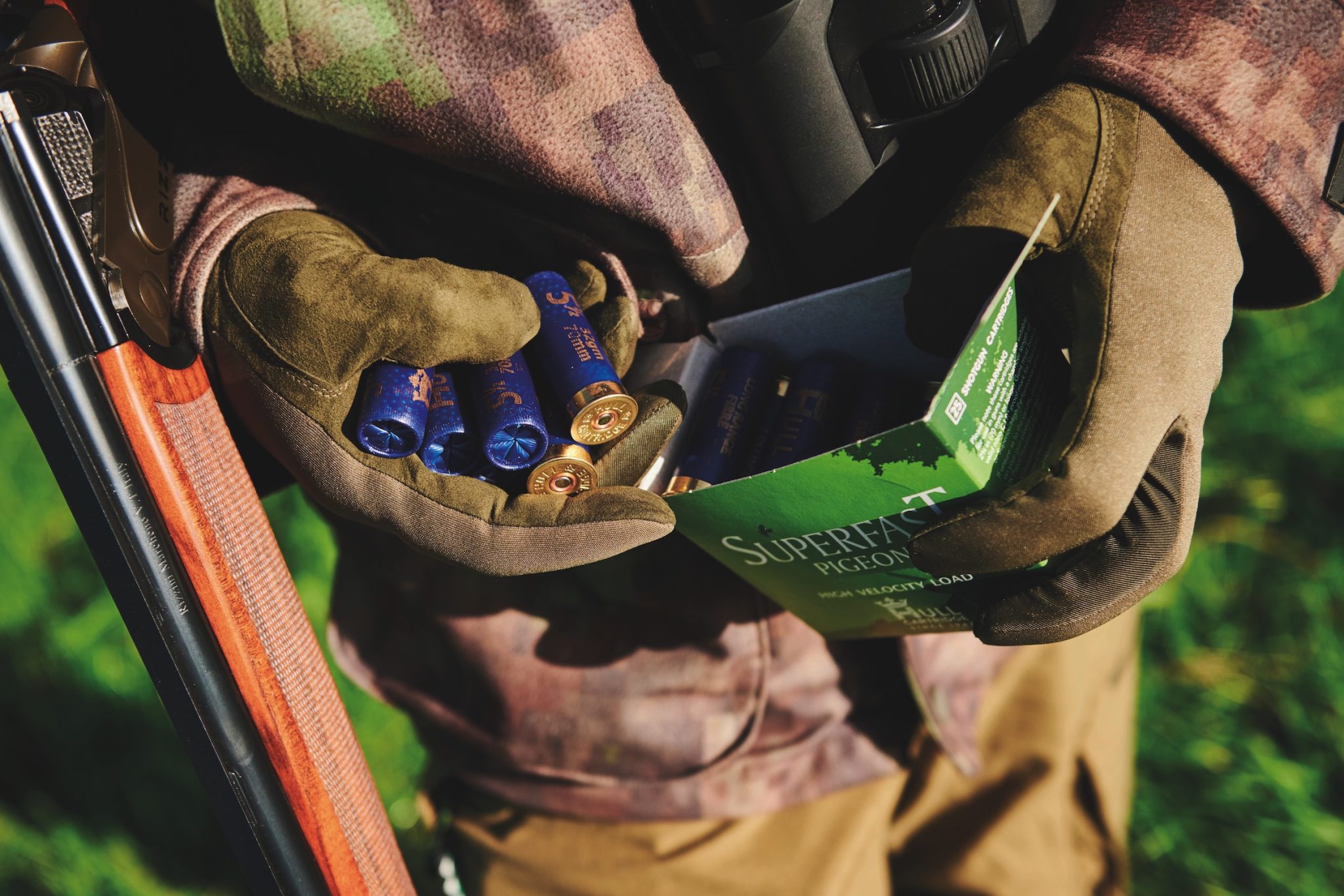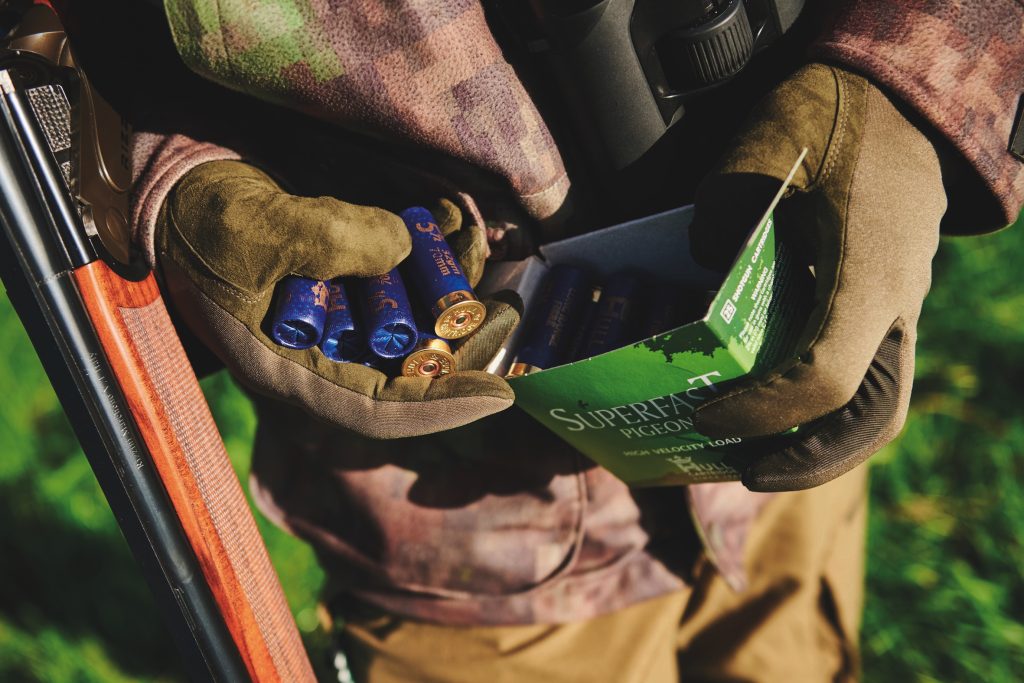The countdown is on for The British Shooting Show – book tickets online today and save on gate price!
Shooting pigeons with an airgun and placing decoys
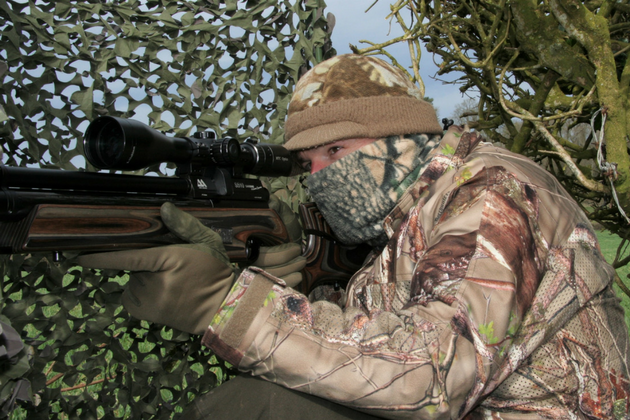
Although a shotgun is usually my tool of choice for dealing with crop-raiding pigeons, shooting pigeons with an airgun is also an option. Out on open fields, these birds can sometimes be persuaded to land among, or at least close to, a decoy pattern, but it doesn’t always work. A more reliable and generally far less frustrating option is to target pigeons in trees that flank the fields where they are feeding. I have had some great days shooting pigeons from prominent sitty trees, which they use as stopping points on their way in and out of their feeding grounds. Woods and spinneys next to the fields the birds are hitting can also be productive, especially around lunchtime and dusk, when pigeons flight back.
(Read the law on pigeon shooting.)
Move quickly but don’t rush
- My priority when planning shooting pigeons with an airgun to move quickly.
- These birds change their habits, and their feeding grounds, at the drop of a hat.
- Fields that are grey with them one day can be completely barren the next as the flock moves on to another area with richer pickings.
- If you see pigeons starting to build up on your ground and fancy a slice of the action, it pays to strike swiftly.
- Don’t be too hasty, though. While it pays to get out quickly, a few minutes of reconnaissance could save you a great deal of wasted time.
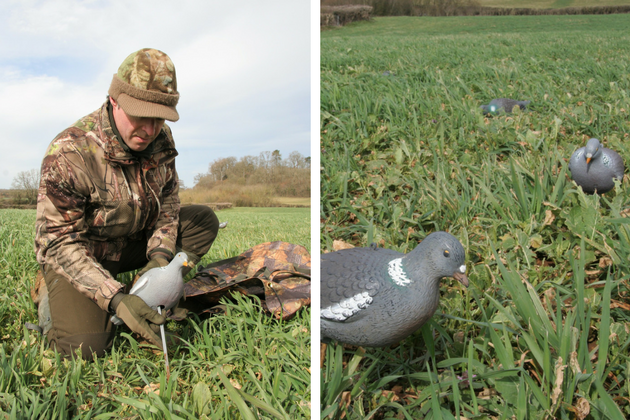
(Left))The nearest and furthest decoys from your hide can be used as handy range markers. (Right) Using different styles of full=bodied decoys and setting them up at varying spacings and angles helps the pattern to look natural
Decoys aren’t magical
A lot of shooters seem to think that decoys possess irresistible magical properties that will pull pigeons to wherever they want them. That couldn’t be further from the truth; set up your fake flock in a place where the woodies don’t want to be and they won’t go near them — no matter how much you’ve spent on fancy flappers. (Read how to use an air rifle on pigeons around the farm.)
Shooting pigeons with an airgun – the ambush
Pause to watch what’s going on before setting up and it will become apparent that birds are using distinct routes to flight in and out from wherever they are feeding. The aim is to base your ambush beneath a line that pigeons are already using. There are more factors to consider before deciding exactly where to site your hide and decoys. Unlike those who use shotguns, airgun shooters are limited to static targets. (Read this piece on FUD pigeon decoys.)
It helps if you can find an area where the crop is low enough for you to get clear shots at birds when they have landed. Such places are not unusual because it’s likely that the crop will either be stifled or flattened by the activity of feeding pigeons. Better still, find yourself a place where you can set up within range of a sitty tree close to an incoming flightline.
Pigeons will often pitch in trees on the field margin to check that the coast is clear before they commit to landing on the ground — and they sometimes flight back to these trees to snooze and digest their food after bingeing on crops. Being able to shoot pigeons from trees makes life a lot easier than trying to get a bead on birds that are on the ground, where they could be obscured by stalks or stubble and will be bobbing up and down as they peck.
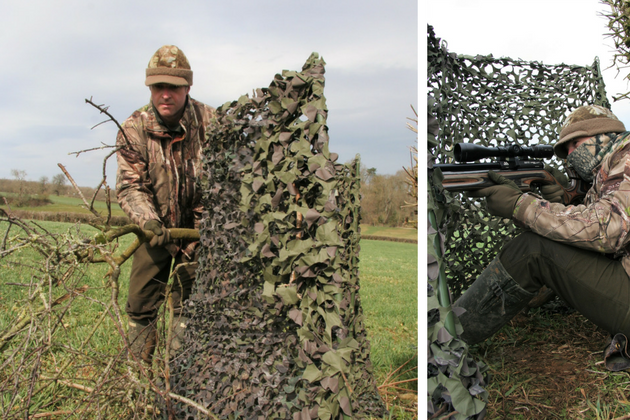
Dressing the hide is about striking a balance between optimum concealment and a quick set up
Once you’ve identified a promising spot, you’ll quickly realise that pigeon decoying is not for those who were seduced by the simplicity of airgun shooting. Aside from your normal kit, you will have to lug hide-building gear and a squadron of decoys to wherever you’re planning to dig in — and you can usually count on that being one of the furthest points from where you’ve parked your car.
I’ve taken to using my decoy bag as a seat on these forays as it saves me from having to carry a beanbag — it’s only a small saving but it does make a difference. I also sacrifice my shooting sticks because it’s usually possible to use hide poles to stabilise shots. As with any type of hide shooting, I aim to weave my camouflage screen into a natural backdrop — a hedge, tree trunk or bank — to help it blend in with the surrounding landscape. Unlike shotgunners, we are able to shoot through the net rather than over it, so I set the poles pretty high.
Hiding the hide
Woodies are sharp-eyed birds and can spot the straight edges and shiny finish of hide poles — wrapping your camo netting around them will help. How far to go in terms of dressing the hide is a quandary. You want it to be as unobtrusive as possible but you don’t want to spend hours creating an invisible cocoon only to find that the birds have pushed off to pastures new by the time you’ve finished your grand design. My approach is to spend a couple of minutes placing dead branches and scraps of vegetation to take the edges off the net.
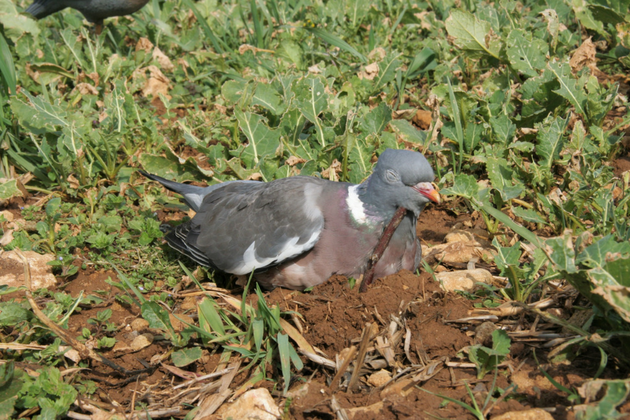
Propping up shot birds is a simple and effective way to enhance the decoy pattern
Setting out the decoys
With the hide in place, it’s time to set out the decoys. My preference is for a wide, U-shaped pattern with a large central landing zone into which incoming birds will hopefully pitch. I try to have the closest decoy about 18m from the hide and the furthest one no more than 35m away. These serve as handy range-markers and, in calm conditions, I’d expect to nail birds that land between them.
The curved trajectory of an airgun pellet means you usually need to apply some holdover or hold under to keep shots on target. You need to know how far away your target is to get it right, and you’re far less likely to spook skittish woodies by checking ranges before they arrive than trying to do it while they’re scanning for danger after pitching in.
Most shooters are aware of the fact that pigeons like to land and take off facing into the wind, and the birds in your artificial flock should reflect this. Don’t line them up too neatly, though — different spacings and angles will look more natural. I rarely use magnets or flappers when shooting with an air rifle but I do like a variety of full-bodied decoys, again with the aim of introducing some natural-looking variation to the pattern. I tend to use about 20 pigeon decoys for the main pattern and a couple of crows just beyond that as confidence boosters — I wouldn’t want to carry many more than that.
My final preparation, as is often the case when I’m shooting in woods is to put on a camouflage head net. I usually dispense with this garment when I’m on the move because I don’t like the way it restricts my vision, but I do like to keep my face hidden when trying to ambush sharp-eyed woodies. It doesn’t take much to spook these flighty birds, and the sight of a human face peering up from the undergrowth is usually enough to send them flapping off into the distance. (Read the best camouflage pattern for airgunners.)
You need to shoot quickly as they don’t always linger for long, but this is no place for flustered pot-shots. Compose yourself and grab a hide pole for extra stability if you can. Head shots can be tricky when birds are pecking at the ground so try to land your pellet just in front of the fold of the wing or right between the shoulders for the clearest route to the heart and lungs.
Birds wise up
As airguns are quiet, it’s not unusual for birds to take flight, circle a couple of times and land back among the decoys after you’ve removed one of their number. But they soon start to wise up after a couple of losses, or if you get a bird that lands belly up. The last thing you want in the landing zone is a dead pigeon with its legs in the air. If this happens, I break cover and add the shot bird to the decoy pattern, pushing a sharpened stick through its chin to make a prop for its head — there is no better decoy than the real thing.
If all goes to plan, you should account for a few birds during your outing and will have even more weight to lug back to the car at the end of the session. But do be prepared for failure — there are days when the pigeons stubbornly refuse to land anywhere near the decoys.
The airgun’s handicap when it comes to taking birds on the wing means the best thing you can do in this situation is tell a shotgunning friend there’s a ready-made hide and shooting opportunity waiting for them to enjoy in the morning. (Read how to buy a second-hand air rifle.)
This article was originally published in 2018 and has been updated.
Related Articles
Get the latest news delivered direct to your door
Subscribe to Shooting Times & Country
Discover the ultimate companion for field sports enthusiasts with Shooting Times & Country Magazine, the UK’s leading weekly publication that has been at the forefront of shooting culture since 1882. Subscribers gain access to expert tips, comprehensive gear reviews, seasonal advice and a vibrant community of like-minded shooters.
Save on shop price when you subscribe with weekly issues featuring in-depth articles on gundog training, exclusive member offers and access to the digital back issue library. A Shooting Times & Country subscription is more than a magazine, don’t just read about the countryside; immerse yourself in its most authoritative and engaging publication.



